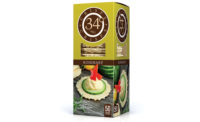Nuts and seeds have long remained dietary staples. But these days, consumers have started to realize the wide range of diversity that these ingredients offer. They provide flavor, texture and nutrition to an increasingly wide variety of snack foods and baked goods. And nuts and seeds are more popular now than ever before.
This increase in popularity is due to several factors. We are learning more about the health benefits of seeds and nuts, and their presence lends better-for-you credibility to product. Plus continued interest in gluten-free has brought many nut and seed ingredients to the forefront of R&D consciousness. Other important trends that seeds and nuts play into include clean-label eating, plant-based protein, whole foods and vegan trends.
The snack factor
One big change in America’s eating behavior is increased snacking. The NPD Group report, “The Future of Eating: Who’s Eating What in 2018” notes that the consumption of better-for-you snack foods is up 14 percent since 2006.
Snacks are being added to traditional diets, and for some, snacks and light meals are replacing the traditional three larger meals. According to Molly Spence, director, North America, Almond Board of California, Modesto, snacking is “a major consumer trend that is not showing any signs of slowing down. Consumers are snacking more and more each year, and 31 percent report nuts as their most-often eaten snack.”
Bars are a top snacking option for consumers today, and nuts regularly go into the mix. Spence suggests that almond-rich bars that add fruit ingredients like dates, cherries, apricots or blueberries, sometimes along with savory spices, align with prevailing trends. Bite-sized breakfast bars are another way to bring almonds to more snacking occasions.
Nuts play into the top attributes that consumers look for in a snack. Spence notes that the 2015 “Snack Mapping Study” from Sterling-Rice Group found consumers cited the following as the top attributes for a snack: convenience (67 percent), great taste (65 percent) and appropriateness for everyday use (60 percent). “Almonds deliver on all three of these attributes, making them a go-to product for product developers and consumers alike,” she says.
As finicky millennial consumers constantly seek variety, producers work to maintain their relevance. Jeff Smith, director of marketing, Global Ingredients Division, Blue Diamond Almonds, Sacramento, CA, observes that “the snackification of food offers a lot of opportunities to reimagine applications with new formulations and combinations of flavors. The R&D team at the Blue Diamond Almond Innovation Center is creating new flavor profiles for almonds and working with manufacturers to help create products that appeal to consumers’ evolving tastes. We are working with flavors such as Mesquite, Maple, Sriracha-style Ginger, Salted Caramel and Honey Roasted.”
Nuts about gluten-free
According to the Celiac Disease Foundation website, 30 percent of the population reports using gluten-free products. Considering that only 1 percent of the population has celiac disease, clearly the popularity of gluten-free diets goes beyond purely medical necessity.
That leaves a lot of product developers scrambling to find substitutes for wheat flour, and many have turned to nut flours. According to the March 2016 “Almond Trends and Applications” report from Innova Market Insights, the bakery category accounts for more than 50 percent of new almond flour introductions tracked since 2011.
According to Jeff Smith, almond flour ranks among the top 100 food items sold on Amazon. “We continue to see expanded offerings of almond flour within grocery, club store and online,” he says.
Almond flour can add notable nutrition to gluten-free foods. Smith notes that almond flour “provides nutrients that can be lacking in baked goods, such as calcium, fiber, iron and protein. It has an amazingly smooth texture, unlike many gluten-free flours that tend to be gritty and rough. Its use in better-for-you products aligns with consumers’ continued adoption of foods reflecting a healthy lifestyle.”
Nut flours and meals also improve the flavor and richness of gluten-free foods. According to Steve Bryant, managing director, food and beverage, MSLGroup, nut meals, which can have a short shelf life, are often best suited to use in fast-moving snack and bakery categories, frozen foods and foodservice bakery applications.
It’s not just flour that’s going to good use. Spence says that almond butter and paste were top almond forms in 2015, and notes that the Almond Board has also seen an increase in the use almond milk for dairy-free applications.
Seed diversity
Seeds fit well into many current eating trends—including sprouting. “We see sprouted as a current and growing trend,” says Tara Froemming, marketing coordinator, Healthy Food Ingredients, part of SK Food International, Fargo, ND. “Our company, Healthy Food Ingredients, offers sprouted seeds including chia and flax. Customers continue to utilize flax and chia in whole form and also in milled forms. We also have a micro-reduced version of chia and flax.”
Froemming also suggests we keep an eye out for mustard seeds. “Mustard seed has been gaining momentum for use outside of typical prepared mustard flour form.”
Chia now goes into more snacks than ever before. One of the first companies to tout the benefits of chia seeds was Mamma Chia, which includes the seeds as a primary ingredient in its snack bars. Chia seeds are known to be high in omega-3s, and contain protein, fiber, antioxidants and calcium.
Beyond the nutritive benefits of chia, Bryant points out that chia is a cultural fit with Latin American consumers, a growing segment of the population. “They have a history of using chia seeds,” he says, noting that these consumers are potential market influencers for smart chia marketers.
Seeds are the new darling of the bread aisle, bringing a new twist to products—often as an exterior visual cue. Multiple Dave’s Killer Bread products and Bimbo Bakeries USA’s Healthfull and Extra Grainy lines are chockful of a variety of seeds, including chia, pumpkin, flax and sesame.
Some of this is a carryover of consumer food preferences from the snack category, where seeds have shown up with increasing frequency in chips and crackers. Byrant notes that seeded breads “are currently the best hope for the weakened bread category. Seeds signal ‘real’ food, heightened nutrition, protein and homemade quality.” He notes that whole seeds stay fresher longer and convey higher quality.
Fruitful connections
Nuts and seeds are good partners for fruits. This combination is a favorite in the trail mix segment, but other areas of snacks and bakery are capitalizing on these connections.
The sweetness of the fruit complements the buttery and salty nut flavor profile. Both almond and walnut marketers suggest that fruits, such as apricots, peaches, blueberries and apples, work as great with nuts. The combination of fruit, nuts and/or seeds is showing up as the hero in new food forms such as crisps—a cross between melba toast and crackers. Wild California offers a variety of such products, including its Fruit N’ Nut Crisps, which include organic wheat flour, pumpkin seeds, pistachios, raisins, cranberries, grape flour and Parmesan cheese.
When a nut is not a nut
While many of us love nuts, they are classified as one of the “big eight” allergens. But solutions exist to deliver some of the eating quality of nuts without raising allergen flags.
Inclusion Technologies, Atchison, KS, offers a line of nut analogues called NadaNut. According to Dennis Reid, vice president of sales and technology, NadaNut ingredients can help formulators “avoid, replace or extend nut usage. NadaNuts are made from wheat germ and comes in many authentic forms and flavors such as pecan, cashew, walnut and pistachio.” Non-GMO versions are available.
Fiberstar, River Falls, WI, offers another potential solution. Amanda Wagner, food technologist, cites fillings and pastes as an example where the company’s Citri-Fi ingredients can mimic nut properties. “Citri-Fi can help maintain the texture, mouthfeel and high eating quality in the finished product,” she says. “Our product is offered in a variety of particle sizes which provides product developers the option of target specific filling or pastry textures.”
With all of this interest in nuts and seeds, expect to see these favorite ingredients show up in even more forms in the snack and baking aisle.








